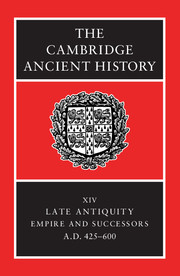Conclusion
Published online by Cambridge University Press: 28 March 2008
Summary
No other volume of The Cambridge Ancient History raises such major questions of periodization or historical interpretation as Volume XIV, the last in the series. Indeed, the very decision to extend the original coverage of the series by two extra volumes and to allow an overlap with the new Cambridge Medieval History is an indication of the lively state of research on this period and the variety of interpretative schemes currently proposed. We can no longer be content with a simple ‘transition from classical antiquity to the Middle Ages’, nor can we propose a single point where the line between them may be drawn. The conventional date of the fall of the Roman empire in the west, confidently placed by previous generations in the year a.d. 476, was already found inadequate by Edward Gibbon, while the lack of interest shown in the supposed event by contemporaries has been noted as a problem by many historians. ‘Transformation’ is now a term more commonly used than ‘fall’ to describe the process of historical change in the west from the last centuries of classical antiquity to the Middle Ages, and the search for a chronological divide is felt with less urgency than before as concentration focuses instead on a longer time-scale of change. Meanwhile, the historic changes in eastern Europe in the late twentieth century encouraged are-examination of the processes which led to the formation of Europe, and in particular a reconsideration of what the very concept of Europe might entail.
- Type
- Chapter
- Information
- The Cambridge Ancient History , pp. 972 - 981Publisher: Cambridge University PressPrint publication year: 2001

